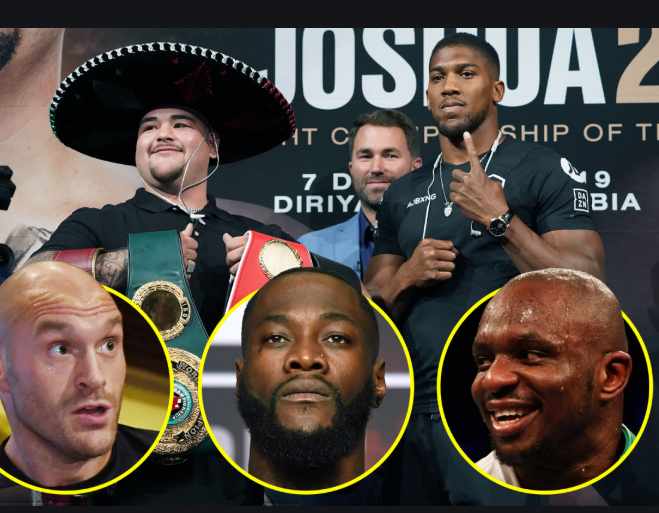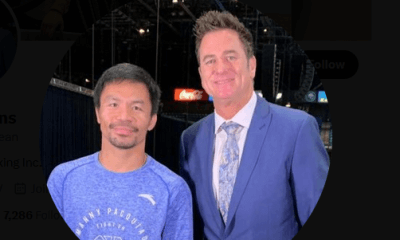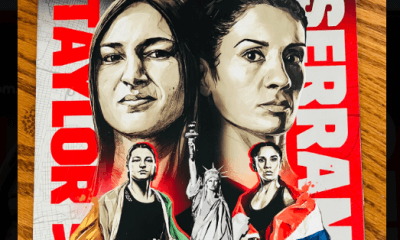Featured Articles
Has the U.S. Lost its Presence in Boxing? Part Two of Our Latest Survey

More than 50 boxing notables shared their thoughts in our latest TSS survey. As is our custom, we listed the respondents alphabetically. Those with last names beginning with the letters “A” through “L” were included in PART ONE. Here’s PART TWO. We welcome your feedback.
PAUL MAGNO-writer and author: The decline of boxing in the U.S. has opened the door for expansion across the globe. So, really, it’s kind of like a good for you, not-so-great for us scenario. At the very least, though, it establishes the fact that boxing is still a sport that can reach the mainstream if presented correctly. American fight fans just have to roll with the punches and accept that they’re no longer the center of the fistic universe. They’ll have to get used to watching fights at odd hours at “away” venues. The American fight game can learn from all of this and rebuild based on those lessons—if it decides one day to smarten up.
ADEYINKA MAKINDE–barrister, writer and contributor to the Cambridge Companion to Boxing: The decline in fighters from Western developed countries after the Second World War saw a corresponding rise from poorer parts of the globe. The rise of the Griffiths and the Paret’s confirmed that trend. Also, if the U.S. does not hold any of the Heavyweight titles, that’s indicative that it is “no longer a major player in professional boxing.” Also reflecting this “re-adjustment” is the box office success of non-American boxers in their homelands. Anthony Joshua can fill stadiums in Britain and command huge guarantees from Saudi sponsors. However, in terms of financial muscle, the situation is less clear as DAZN is a multinational brand with huge American input. ESPN and PBS are still in there. There are fewer American boxing superstars, but the US continues to be a major player as a centre for raising monies as well as locations such as Las Vegas and NYC.
LAYLA McCARTER-WIBF welterweight champion and former world title-holder in multiple divisions: Perhaps the U.S. has lost its presence as the major player in pro boxing, but I believe this trend to be temporary. Promoters and networks come and go. Great ones like King and Arum are aging out of the sport. The UK is having its run now, but I’m confident that new promoters will emerge in the U.S. and once again be successful.
KELSEY McCARSON-TSS writer: I think the U.S. will remain the fulcrum of professional boxing for the foreseeable future but that the rise in global audiences that are able to digitally cross borders will reveal more competition than ever for U.S.-based promotional companies. It would seem like that’s a good thing. One of my favorite things about boxing over the last few years is Eddie Hearn’s rise to global prominence. In the old days, Bob Arum and Oscar De La Hoya had a virtual monopoly through their partnerships with HBO. Now, there are many more ways fighters can get paid to fight on TV and streaming platforms.
***************************
“…how can we profess to be a major player when the sport is on life support here in the United States with no vaccine to save it?” Dr. Stuart Kirschenbaum
***************************
SCOOP MALINOWSKI-writer, author, creator of BIOFILE: America no longer produces the abundance of great champions it once did. The best fighters are developed in other nations, particularly Eastern Europe. American tennis is in a similar situation.
JASON MARCHETTI-boxing writer: I disagree. The US is still a major player in professional boxing, although there continues to be inconsistencies of what promoters and fighters say versus what they agree to. The sanctioning bodies and promoters control which fights get made instead of the fans, and its killing the sport in the US.
LARRY MERCHANT-legendary HBO commentator; 2009 IBHOF inductee: Trick question. Boxing hasn’t been a mainstream sport in the U.S. for decades, yet four networks show boxing regularly and we have more consequential fighters and fights in the lightweight, welterweight and middleweight divisions by far than any other country. And even though we may have to wait for another comeback by George Foreman to make a heavyweight impact on casual fans, most heavyweight championship fights recently have been staged, yes, in the U.S. That said, Great Britain and probably Mexico reign as the pound-for-pound champions for their “presence”—or passion— and that does count for a lot.
ROBERT MLADINICH–Former fighter, retired NYC Detective, author, writer, and actor. It’s sad but the United States has taken a back seat to Europe in attracting fans to live shows. Wilder vs. Fury 2 could have brought nearly 100,000 fans to an arena in England. Years ago that fight would have broken attendance records here.
DIEGO MORILLA-boxing writer; Copy Editor of The Ring en Español : Sometimes certain countries gain more ground at certain times, depending on the level of activity of their fighters. Japan is now enjoying huge success. The quality of their fighters in those lower divisions is off the charts. That’s just an example of one country “exploding” in a particular region. Since the most visible weight class is the heavyweights, fans tend to assess the value of boxing in general depending on the quality displayed in that division. The U.K now rules the heavyweights with as many as five in the top 10. It used to be Eastern Europe and the Klitschko’s. Now it’s England. This surge may be responsible for this notion that the US is losing ground in boxing, but the level of quality in the U.S. is so deep that it’s only a matter of time before it bounces back to the top and claims at least half of the pound-for-pound names, as well as a similar number of names in the list of best paid and most relevant athletes in the world.
ERNESTO MORALES (aka GENO FEBUS)-writer, former fighter: For decades the Western Hemisphere fighters & trainers, managers, promoters, and fans were spoiled believing they had a never-ending superiority. When a U.S. fighter lost abroad it was considered a fluke/upset. As time went, non-U.S. fighters trained harder, their hunger grew, and became CONFIDENT that they were just as good if not better, with the main reason for their success being their extensive and superior amateur programs. Heavyweight is the most influential division worldwide, and it’s OWNED by Europe.
LUIS PABON- elite referee: Undoubtedly the Europeans have been gaining ground, especially the larger weights. Uzbekistan, Russia, Ukraine, they are very good, but even in the USA the 130, 135, 147, 160 are the best divisions, and the Mexican-Americans, who are USA, they are also very good. I think it is global. Europe, Japan, Mexico, they are very good but even together they do not beat the USA.
JOE PASQUALE-professional judge: Team sports are supported & easier. And since WW2 there are fewer inner city gyms. Less media attention for amateur boxing world & Olympic events has resulted in fewer participants and professional contenders from the USA. Boxing has become more global like the world economy. Talent is emerging from countries where there is more national and government support for boxing. China has massive amateur boxing programs with thousands of boxers supported and educated. The USA barely does that for their amateur team sports and nothing for boxing except at a minimum on the Olympic level.
DENNIS RAPPAPORT: former co-manager of Gerry Cooney, among others; elite promoter: Historically the best fighters were from the U.S. In recent years the Eastern Europeans, Germany and England have made major strides. England has produced some excellent fighters and the sport’s popularity has been overwhelming. The Russians, Ukrainians and former members of the USSR are very hungry and determined and have impressive amateur pedigrees. The Latins have always been a major force and now with the emergence of The Philippines, pose even more competition. Bottom Line is the momentum, at least for now, has shifted away from US dominance.
JOHN RASPANTI-lead writer/editor for MaxBoxing; author: I don’t agree. Las Vegas, New York and Los Angeles are major players in promoting and staging the most important fights. Tyson Fury and Deontay Wilder fought last month in Vegas. Fight three will probably be back in Sin City. Vasyl Lomachencko and Teofimo will likely fight in New York in a few months. Major fights are scheduled in Southern California. The United States is a big time player in the sweet science and will continue to be in the foreseeable future.
CLIFF ROLD-writer and Managing Editor of BOXING SCENE: How could it have lost its presence? By and large, the US is still the richest market in the sport. This is where the greatest fortunes are possible. As long as this is true, it will be a premier part of the game.
FRED ROMANO-boxing historian, author and former HBO Boxing consultant: There certainly is a broader representation of quality fighters from places outside the United States compared with a couple of decades ago. Boxing is also more global in terms of financial control and preferred venues as well. Nevertheless, the US boxing presence is still stout, and the US will remain a major player in the sport in all respects.
DANA ROSENBLATT-former World Middleweight Champion; inspirational speaker and commentator: The U.S. is close to losing its lead in worldwide boxing due to boxing not being as widely present in the Boys Clubs. The loss of weekly fights on the major networks is also another reason why we have slipped in terms of our dominance of the sport.
TED SARES-TSS writer: The U.S. is behind at the top and especially so in the heavyweight division. It never was much of a force at the bottom divisions where Asians and Latinos thrive. It’s in the middle that the U.S. will maintain a competitive, if not premier, spot with other nations. Fighters like Crawford, Tank, Spence, Thurman, Porter, Danny Garcia, Mikey Garcia, Plant, Andrade, the Charlos, Hurd, Williams, Harrison, Lubin, Prograis, Hooker, Zepeda, Diaz, JR., Farmer, and Colbert ensure this.
RICHARD SCHWARTZ-elite cut-man and RING 10 board member: The rest of the world is catching up to the U.S. just like in basketball. We still produce some of the world’s best like Mayweather, Crawford, Spence, the Garcia’s, Wilder, etc. Boxing has always been populated by those from the lowest socio-economic group and will continue to be, but many good athletes are going into other athletic endeavors. Many world champs and great fighters are now coming out of European countries. When I was growing up, I could only think of Ingemar Johansson. New York is no longer the mecca of boxing; that title has been taken over by Las Vegas, but the sport will continue to survive the world over.
ICEMAN JOHN SCULLY-former world title challenger; you name it in boxing, he’s done it!: I wouldn’t say that the USA has lost its presence entirely as the major player in the game but we have been joined by the most serious competition we have ever had. The U.K. may actually be number one right now but that doesn’t mean the U.S. has been wiped off the boxing map. Many countries who were not able to turn out professionals back in the 80’s like Cuba and Russia are now seeing some of their greatest amateurs turning pro and they are simply achieving what many great Americans have done in the past. We are not off the map; we have just been joined by many others, that’s all.
MIKE SILVER- author, writer, historian: Until the USA has an undisputed world heavyweight champion, it will appear to have lost dominance over the sport. Although certainly not as dominant a major player as in previous decades, the USA still holds 15 of the 37 title belts from featherweight to heavyweight. That’s 40 percent, which isn’t bad. I don’t include the six weight classes from light flyweight to bantamweight because there just aren’t enough small Americans competing in those divisions, nor is there much interest in them.
ALAN SWYER– film producer, creator “El Boxeo”: Though boxing has gotten a recent surge thanks to the heavyweight division — first Ruiz’s upset win, then Fury mauling Wilder — the powers that be have accepted its status as a niche sport. Bud Crawford may well be the best fighter in the world, but outside of fight fans, who knows about him? Or Lomachenko? How many newspapers even cover boxing regularly? Far too much changed when the Olympics — the spawning ground for Ali, Leonard, Oscar, and others — not merely de-emphasized it, but worse turned it into fencing. As I showed in my documentary “El Boxeo,” the popularity of the sport today owes largely to Latinos, followed by Brits and Eastern Europeans. Other than Mayweather (plus Andy Ruiz during his fifteen minutes of fame), what boxer has captured the imagination of the casual American sports fan of late?
RICHARD TORSNEY-former fighter; boxing official: (1) Boxing has always been practiced by the downtrodden. Young people in the US have more opportunities than in the past. Education is broadly available. US athletes can choose sports such as basketball, football, soccer, baseball, etc., that affords them reduced or even free college tuition. Boxing does not. Thus, we have fewer practitioners. (2) In days gone by the US media treated boxing as an important sport. It doesn’t any longer. Without publicity, interest is lost, fans don’t fill arenas and young folks don’t get to see their names and photos in the paper. Without media coverage it’s like a tree falling in the woods…, it makes no noise.
BOB TRIEGER-boxing publicist: I agree that America has lost some of its presence, but not all of it. Every trend in boxing has been in cycle and I’m confident that Americans will once again rule. NYC and LV remain two of the top markets in the world. It will be interesting to watch how America responds to the Coronavirus pandemic. America still produces many of the best boxers and that will not change,
GARY “DIGITAL” WILLIAMS-the voice of Boxing in the Beltway: I think it depends on the weight class. We are starting to lose credibility in the heavyweight division definitely. However, from 140-160, I think the US is in good shape.
PETER WOOD-author, former fighter, NY Boxing Hall of Fame inductee: I will answer this question with another question: If the US has lost its presence as a major player in professional boxing, who has replaced us?…I rest my case.
Observations:
The responses were pretty much evenly divided between “agree” and “disagree.”
Surprisingly (at least to me), many felt that as long as the U.S. does not rule the heavyweight division, it does not rule boxing.
I thought Brian “The Bizz” Bizzack summed up the downward trend of U.S. Boxing very well, but Larry Merchant made the case for the U.S. and many agree with his analysis if not his conclusion.
Iceman John Scully and many others opined that other countries have simply caught up with the U.S–and that’s a difficult one to debate.
Clearly, media coverage has been especially poor. Rich Torsney nailed it when he says, “Without media coverage it’s like a tree falling in the woods…, it makes no noise.”
Once again, my heartfelt thanks to everyone that contributed, particularly in these difficult times.
Check out more boxing news on video at The Boxing Channel
To comment on this story in The Fight Forum CLICK HERE
-

 Featured Articles3 weeks ago
Featured Articles3 weeks agoVito Mielnicki Jr Whitewashes Kamil Gardzielik Before the Home Folks in Newark
-

 Featured Articles4 days ago
Featured Articles4 days agoResults and Recaps from New York Where Taylor Edged Serrano Once Again
-

 Featured Articles1 week ago
Featured Articles1 week agoFrom a Sympathetic Figure to a Pariah: The Travails of Julio Cesar Chavez Jr
-

 Featured Articles3 days ago
Featured Articles3 days agoResults and Recaps from NYC where Hamzah Sheeraz was Spectacular
-

 Featured Articles4 weeks ago
Featured Articles4 weeks agoCatching Up with Clay Moyle Who Talks About His Massive Collection of Boxing Books
-

 Featured Articles1 week ago
Featured Articles1 week agoCatterall vs Eubank Ends Prematurely; Catterall Wins a Technical Decision
-

 Featured Articles3 weeks ago
Featured Articles3 weeks agoMore Medals for Hawaii’s Patricio Family at the USA Boxing Summer Festival
-

 Featured Articles4 days ago
Featured Articles4 days agoPhiladelphia Welterweight Gil Turner, a Phenom, Now Rests in an Unmarked Grave



















